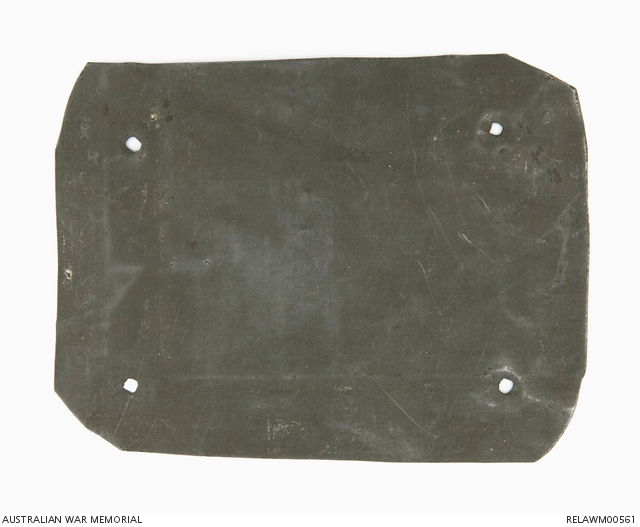| Place | Europe: France, Picardie, Somme, Albert Bapaume Area, Pozieres Area, Pozieres |
|---|---|
| Accession Number | RELAWM00561 |
| Collection type | Heraldry |
| Object type | Heraldry |
| Physical description | Tin-plated steel |
| Location | Main Bld: First World War Gallery: Western Front 1916: Pozieres |
| Maker |
Unknown |
| Place made | France |
| Date made | 1916 |
| Conflict |
First World War, 1914-1918 |
Rectangular tin plate recognition marker : 2 Australian Division, Pozieres

Irregular rectangular piece of tinned steel plate, with a hole punched approximately 2 cm from each corner. Very little of the tin finish remains upon the metal, which has an overall dull grey appearance.
The 2nd Australian Infantry Division was issued with tin plates before their unsuccessful attack on the Pozieres heights and the trenches known as 'OG 1' and 'OG 2' (the reference being to the 'Old German' lines) on 29 July 1916. The shiny plates were sewn to the rear of the men's tunics, and it was intended that they would provide artillery or aircraft observers with a visible confirmation of the position of the attacking troops. They were most unpopular with their wearers, who considered that they were also likely to attract the unwelcome attention of the enemy. The lack of tinned finish remaining on this example may thus represent an attempt by the wearer to make it less conspicuous, although it may also be a natural result of age and wear. Charles Bean refers to them as 'the hated tin discs', and notes that: 'the troops ... went through this fight with the feeling that by some one's folly they carried these flashing targets between their shoulder-blades wherever they went.' When the division made its successful second assault on the same positions on 4 August, the plates were again worn, but were concealed, and exhibited only when required.